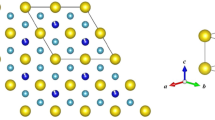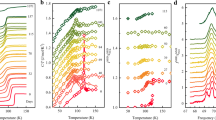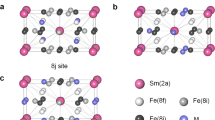Abstract
Most solids expand when they are heated, but a property known as negative thermal expansion has been observed in a number of materials, including the oxide ZrW2O8 (ref. 1) and the framework material ZnxCd1−x(CN)2 (refs 2,3). This unusual behaviour can be understood in terms of low-energy phonons1,2,3,4,5,6, while the colossal values of both positive and negative thermal expansion recently observed in another framework material, Ag3[Co(CN)6], have been explained in terms of the geometric flexibility of its metal–cyanide–metal linkages7. Thermal expansion can also be stopped in some magnetic transition metal alloys below their magnetic ordering temperature, a phenomenon known as the Invar effect8,9, and the possibility of exploiting materials with tuneable positive or negative thermal expansion in industrial applications has led to intense interest in both the Invar effect and negative thermal expansion. Here we report the results of thermal expansion experiments on three magnetic nanocrystals—CuO, MnF2 and NiO—and find evidence for negative thermal expansion in both CuO and MnF2 below their magnetic ordering temperatures, but not in NiO. Larger particles of CuO and MnF2 also show prominent magnetostriction (that is, they change shape in response to an applied magnetic field), which results in significantly reduced thermal expansion below their magnetic ordering temperatures; this behaviour is not observed in NiO. We propose that the negative thermal expansion effect in CuO (which is four times larger than that observed in ZrW2O8) and MnF2 is a general property of nanoparticles in which there is strong coupling between magnetism and the crystal lattice.
This is a preview of subscription content, access via your institution
Access options
Subscribe to this journal
Receive 12 print issues and online access
$259.00 per year
only $21.58 per issue
Buy this article
- Purchase on Springer Link
- Instant access to full article PDF
Prices may be subject to local taxes which are calculated during checkout



Similar content being viewed by others
References
Mary, T. A., Evans, J. S. O., Vogt, T. & Sleight, A. W. Negative thermal expansion from 0.3 K to 1050 K in ZrW2O8 . Science 272, 90–92 (1996).
Phillips, A. E., Goodwin, A. L., Halder, G. J., Southon, P. D. & Kepert, C. J. Nanoporosity and exceptional negative thermal expansion in single-network cadmium cyanide. Angew. Chem. Int. Ed. 47, 1396–1399 (2008).
Goodwin, A. L. & Kepert, C. J. Negative thermal expansion and low-frequency modes in cyanide-bridged framework materials. Phys. Rev. B 71, 140301 (2005).
Ramirez, A. P. & Kowach, G. R. Large low temperature specific heat in the negative thermal expansion compound ZrW2O8 . Phys. Rev. Lett. 80, 4903–4906 (1998).
Ernst, G., Broholm, C., Kowach, G. R. & Ramirez, A. P. Phonon density of states and negative thermal expansion in ZrW2O8 . Nature 396, 147–149 (1998).
Hancock, J. N., Turpen, C., Schlesinger, Z., Kowach, G. R. & Ramirez, A. P. Unusual low-energy phonon dynamics in the negative thermal expansion compound ZrW2O8 . Phys. Rev. Lett. 93, 225501 (2004).
Goodwin, A. L. et al. Colossal positive and negative thermal expansion in the framework material Ag3[Co(CN)6]. Science 319, 794–797 (2008).
Wasserman, E. F. Invar: Moment–volume instabilities in transition metals and alloys, in Handbook of Magnetic Materials: A Handbook on the Properties of Magnetically Ordered Substances, Vol. 5, ch. 3 (eds Bushow, K. H. J. & Wohlfarth, E. P.) (Elsevier Science, 1990).
Khmelevskyi, S., Turek, I. & Mohn, P. Large negative magnetic contribution to the thermal expansion in iron–platinum alloys: quantitative theory of the Invar effect. Phys. Rev. Lett. 91, 037201 (2003).
Asbrink, S. & Norrby, L. J. A refinement of the crystal structure of copper(II) oxide with a discussion of some exceptional e.s.d.’s. Acta Crystallogr. B 26, 8–15 (1970).
Forsyth, J. B., Brown, P. J. & Wanklyn, B. M. Magnetism in cupric oxide. J. Phys. C 21, 2917–2929 (1988).
Yamada, H., Zheng, X. G., Soejima, Y. & Kawaminami, M. Lattice distortion and magnetolattice coupling in CuO. Phys. Rev. B 69, 104104 (2004).
Nikolaev, V. I. & Shipilin, A. M. On the thermal expansion of nanoparticles. Phys. Solid State 42, 112–113 (2000).
Li, W. H., Wu, S. Y., Yang, C. C., Lai, S. K. & Lee, K. C. Thermal contraction of Au nanoparticles. Phys. Rev. Lett. 89, 135504 (2002).
Bragg, E. E. & Seehra, M. S. Magnetic susceptibility of MnF2 near TN and Fisher's relation. Phys. Rev. B 7, 4197–4202 (1973).
Nishibori, E. et al. The large Debye–Scherrer camera installed at SPring-8 BL02B2 for charge density studies. Nucl. Instrum. Methods A 467–468, 1045–1048 (2001).
Izumi, F. & Ikeda, T. A Rietveld-analysis program RIETAN-98 and its applications to zeolites. Mater. Sci. Forum 321–324, 198–204 (2000).
Bartel, L. C. & Morosin, B. Exchange striction in NiO. Phys. Rev. B 3, 1039–1043 (1971).
Acknowledgements
The authors would like to thank W. J. Moon and E. Tanaka at the High Voltage Electron Microscopy Laboratory, Kyushu University, for taking the electron micrographs of the nanoparticles.
Author information
Authors and Affiliations
Contributions
X.G.Z. conceived and designed the experiments. H.K., H.Y., X.G.Z. and K.K. performed the experiments. H.K. and X.G.Z. analysed the data. H.Y., C.N.X. and Y.I. contributed NiO and analysis tools. X.G.Z. wrote the paper. All authors discussed the results and commented on the manuscript.
Corresponding author
Rights and permissions
About this article
Cite this article
Zheng, X., Kubozono, H., Yamada, H. et al. Giant negative thermal expansion in magnetic nanocrystals. Nature Nanotech 3, 724–726 (2008). https://doi.org/10.1038/nnano.2008.309
Received:
Accepted:
Published:
Issue Date:
DOI: https://doi.org/10.1038/nnano.2008.309
This article is cited by
-
Hypocrystalline ceramic aerogels for thermal insulation at extreme conditions
Nature (2022)
-
Plastic and low-cost axial zero thermal expansion alloy by a natural dual-phase composite
Nature Communications (2021)
-
Giant anisotropic thermal expansion actuated by thermodynamically assisted reorientation of imidazoliums in a single crystal
Nature Communications (2019)
-
The effect of ZrO2 on the crystallization of a glass in the system BaO/SrO/ZnO/SiO2: surface versus bulk crystallization
Journal of Materials Science (2017)
-
Ba1−xSrxZn2Si2O7 - A new family of materials with negative and very high thermal expansion
Scientific Reports (2015)



